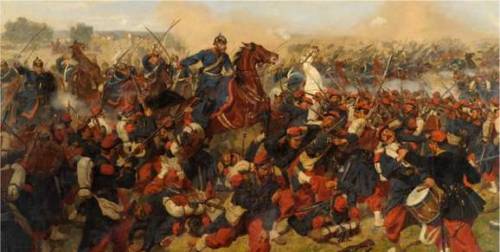peashooter85:The Gras Rifle Part I — The Model 1866 ChassepotFielded by the French Army from the 187
peashooter85:The Gras Rifle Part I — The Model 1866 ChassepotFielded by the French Army from the 1870′s all the way up to World War I, the Gras was France’s first self contained metallic military bolt action rifle. A rugged, reliable, and accurate rifle, it served not only with France, but with countries all over Europe, Asia, and South America. Before I can start this series on the Gras rifle however, I must first do a post on its direct predecessor, the Model 1866 Chassepot needle rifle.In 1841 a German gunsmith named Johann Niklaus von Dreyse invented the needlefire rifle, the first bolt action rifle to be adopted by a major military power. The Dreyse needle rifle was a single shot breechloading bolt action rifle which fired a combustible paper cartridge. It was called a “needle rifle” because the firing pin was essentially a large needle which pierced the paper cartridge, detonating the firing pin placed in the center of the cartridge and thus discharging the round.With this new breechloading system, soldiers could fire around 10 -12 shots a minute at a time when everyone else was using muzzleloading rifled muskets which could fire 3-4 shots a minute. The Prussian military quickly adopted the rifle and began production en masse. The Dreyse needle rifle was an amazing technological advantage for the Prussians. One of many technological and organizational advantages that allowed Prussia to defeat Denmark in 1864 and the Austrian Empire in 1866. Europe watched as Prussia grew from a small kingdom straddling Eastern and Western Europe into a unified German state. Next door neighbor and European superpower France took notice, and it quickly became clear that the two nations would come to blows. With the successes of the Dreyse needle rifle, France wanted in on needlefire technology as well. In 1866 the Antoine Alphones Chassepot introduced the Model 1866 Chassepot. Chassepot constructed two earlier prototypes which were bolt action rifles utilizing a percussion cap system, however it was his third model with a needlefire system which drew the attention of the French military. The new Chassepot had many features which gave it an edge over the Dreyse, in fact what Chassepot created was an all around superior rifle. One of the most important improvements to the needlefire system was it’s action. Before firing the action needed to be cocked by hand. This was done by pulling back on a knob at the rear of the bolt, then opening the action, inserting a cartridge, closing the action, and pulling the trigger.With the Dreyse the user had to pull back on a knob at the end of the bolt to unlock the action. The user then opened the action, inserted a cartridge, and closed the action. Once closed, he then had the push the knob forward to lock the action and set spring tension on the firing pin. Essentially Chassepot was able to simplify the needlefire action thus eliminating a step in the loading and firing process.In addition to this simplified action, the bolt head featured a rubber O-ring or gasket which sealed the chamber when the action was closed. This prevented hot gasses from escaping and blowing in the eyes of the user, a problem common with the Dreyse rifle.Perhaps the most important improvement with the Chassepot was its ammunition. The older Dreyse fired a .61 caliber oval shaped bullet which was smaller than the bore of the rifle. The bullet was wrapped in a paper sabot which made contact with the rifling. The Chassepot fired a .433 caliber conical shaped bullet which was to caliber with the bore, allowing the bullet itself to make contact with the rifling. This combined with the gas seal system gave the Chassepot 33% more muzzle velocity than the Dreyse, better accuracy, and 400 meters more range compared to the Dreyse. Another simple yet important improvement was the placement of the primer in the cartridge. The Dreyse cartridge had the primer placed in the center of the cartridge, thus the needle firing pin had to pierce halfway through the cartridge in order the set off the firing pin. As a result, the firing pins of Dreyse rifles tended to wear out quickly. The French had the good sense to simply place the primer at the end of the cartridge. In 1871 the inevitable war with Prussia began as the Prussian Army and an alliance of of German states invaded France, beginning the Franco Prussian War. The Chassepot rifle made it’s first grand battlefield debut and quickly showed its superiority over the Dreyse. However, the Prussians were supior in many other areas such as artillery, transportation and logistics, communications, training, organization, tactics, and leadership. In six months, the Prussians stormed through France, killing 138,000 French soldiers, capturing another 400,000 , capturing Emperor Napoleon III, and occupying Paris, all while losing around 18,000 men.While the Franco Prussian War signaled the end of the Second French Empire it was not the end of the Chassepot. Needlefire technology would become obsolete with the adoption of the self contained metallic cartridge, and the Chassepot would adapt, leading up to the Gras rifle.To be Continued… -- source link



